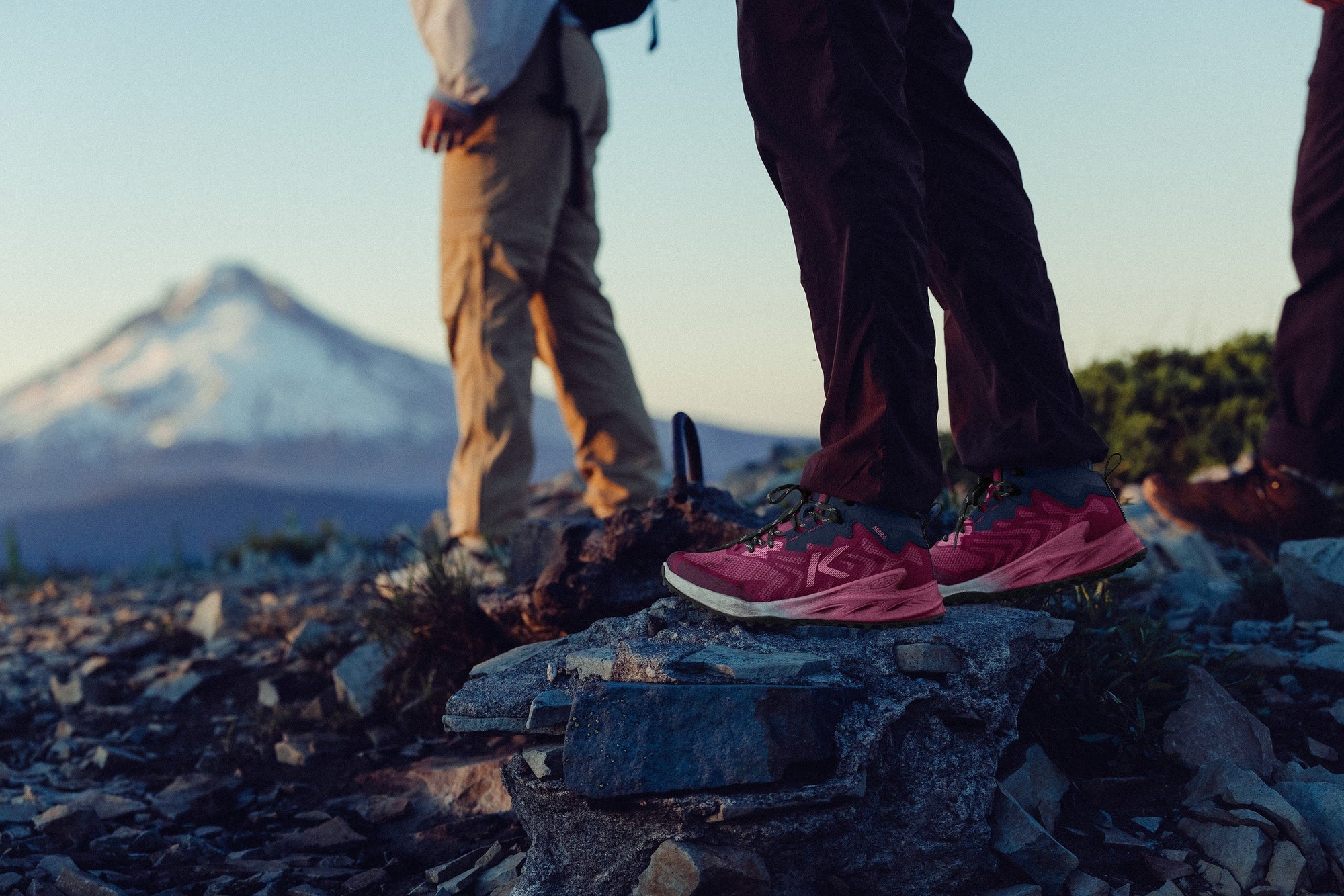In Portland, winter consists of scraping windshields and clearing leaves from neighborhood storm drains. Across the globe, though, winter means everything from balmy 50-degree temps to waist-high snow drifts. That’s why we offer a variety of insulation levels—so you can pick the right weight without adding unneeded bulk.
Our winter boots feature our signature lightweight insulation, called KEEN.WARM. It’s extremely compressible and light for the warmth it provides, plus retains its insulating ability, even when damp. (We've also found a way to use fibers made from recycled plastic bottles for warmth with less impact on the planet.)
How Much Insulation Do You Need?

Obviously, you’re going to want more winter protection if you’re snowshoeing than if you’re, say, trekking from the parking garage to the office, which is why our boots come in a range of weights, from 100-600 grams.
Here's some help to pick the right insulation level for your activities and climate:
100g insulation
Best for: Around town and mild climates
Temperature rating: -4°F/-20°C
KEEN picks:
Hoodzerra II boot
Kaci III winter boot
Kids' Howser II waterproof chukka
Most of our “around town” winter boots feature this weight, which is ideal for mild winter conditions. Think about this as the type of boot you’d wear when you won’t be outside for long periods, like going from the car to the ski lodge.
200g insulation
Best for: Cold-weather hiking
Temperature rating: -25°F/-32°C
KEEN picks:
Revel IV polar waterproof boot
Greta winter boot
Kids' Kanibou winter boot
The majority of our winter hiking boots and work shoes and boots offer 200g of insulation. This amount provides a barrier between you and the chill without adding too much bulk. It’s ideal for a higher level of activity, like hiking. If you’re going to be doing more standing than moving, you might consider one step warmer.
400g insulation
Best for: All-day winter activities and cold climates
Temperature rating: -40°F/-40°C
KEEN picks:
Revel IV high polar boots
This range captures our more extreme winter boots. These are a good choice if you live in the colder pockets of the world or like to enjoy powder days in the mountains or at the sled hill.
600g insulation
Best for: Working in extremely cold conditions
Temperature rating: -55°F/-48°C
KEEN picks:
Camden 8" insulated work boot (carbon toe)
Dover 8" insulated work boot (carbon toe)
Evanston 8" insulated work boot (soft toe)
Independence 8" insulated work boot (carbon toe)
At the time of this writing, we have four severe winter weather work boots. If you’re spending your entire day out in the elements—and those elements are extra cold—600g might be the perfect weight.
Something interesting to note: Due to the colder temps up north, our Canadian work shoes and boots offer heavier insulation than our U.S. versions.

KEEN.WARM FAQs
What about those temperature ratings? When it comes to choosing an insulated boot, it’s important to focus on both the insulation weight and the temperature rating. That’s because the warmth of a boot depends on a lot of variables—your circulation, metabolism, how much you sweat, the construction of the shoe, how snugly/loosely the boot fits, and what type of socks are worn.
How is it tested? In order to test styles with KEEN.WARM, we plug the shoe from the top and place it in an insulated cold box. We then leave the shoe in the insulated cold box for 30 minutes. Afterwards, we measure to see how much the temperature dropped inside the shoe.
What happens if it gets wet? KEEN.WARM absorbs less than 1% of its weight in water, which means that it retains heat, even under soggy conditions.
How about sizing? We got a tip from our friends in the KEEN Garage: When choosing a 400g insulated boot, like the Revel IV high polar boot for men and women, go up half a size. That extra insulation makes for a snug fit and you want to make sure there is room for your toes to wiggle, especially when walking downhill or snowshoeing.
You might also consider how much extra bulk your favorite winter socks will add. If you’re buying shoes in person, bring those socks along trying them on to ensure the best fit.
If you’re going to be tackling snowdrifts, consider an 8" boot. That extra two inches provides extra warmth and a taller snow barrier.

More Ways to Stay Warm
Our KEEN.WARM insulation doesn’t work on its own. There are quite a few elements that work together to ensure toasty toes.
KEEN.DRY: Insulation works in tandem with waterproofing—it’s hard to have warm feet if they’re soaked from slush (or sweat). KEEN.DRY is our proprietary waterproof, breathable membrane that lets vapor out without letting water in.
Thermal Heat Shield Barrier Footbed: This thermal foil barrier inside the footbed keeps the cold out and the heat in by harnessing radiant heat—plus, it has a nice, wooly softness on the outside for added insulation.
Heat Trapolator: A handful of our boots, like the Men's and Women's Revel IV boot, offer three layers of innovative heat-trapping materials that are sandwiched underfoot to hold warm air in. This works a lot like the insulation in your house.
Boot height: Another tip from the KEEN Garage: If you’re going to be tackling snowdrifts, consider an 8" boot (most of our hikers are 6"). That extra two inches provides extra warmth and a taller snow barrier.
Socks: It’s nice to have socks of varying weights and thicknesses to complement fluctuating temperatures. This also extends the temperature range of your boots. Look for medium weight crew or over-the-calf socks in merino wool to keep feet warm and dry.
Gaiters: Okay, so we don’t sell gaiters, but if you’re hiking in snow, they’re key to warmer feet. Many of our insulated hiking boots include a gaiter clip, so they are easier to attach.
Want more specific winter boot recommendations? Get tips for choosing the perfect winter boot—or discover how to pick winter boots for kids.













